This is a short list of shochu that I like. Every single one of these bottles (all 33 of them) is from my personal collection, and please take my word for it that I have tested each for quality. The reviews, I trust it goes without saying, are completely independent. I hope that you will be able to find at least a few of these at a liquor shop, restaurant, or internet retailer near you. Please bear in mind that my underlined serving style recommendations might not be for everyone, so if you’re not enthused, don’t worry. Keep adjusting until you find a style that suits your personal taste.
I have done my utmost to track down the specifics of each bottle’s kōji kin and distillation method, but I was not 100% successful. We’ll just chalk this up to “trade secrets” since both are inseparable from the quality of the final product. Check the comments for each bottle to find extra notes on the ingredients and any aging-related information that I was able to uncover. However, please bear in mind that the details listed below are not the entire picture. Just because a distillery tells people that a specific shochu was distilled at atmospheric pressure does not mean that it hasn’t been blended with a previous year’s shochu to help tame some of its more bracing fragrances and flavors. There’s a lot of unannounced blending that goes on, and it’s not something that distilleries are currently obliged to acknowledge on the label, although many do. The takeaway? There’s a whole lot more to the story of each shochu listed here than meets the eye.
Potato (imo) shochu

Bessenjukusei Sakurajima (別撰熟成 桜島 / べっせんじゅくせい さくらじま) Hombo Shuzō, Kagoshima Prefecture, Japan
ABV: 25%, Kōji: rice (black kōji kin)
Distillation: atmospheric distillation
Recommended serving style:
Neat
Rocks
Mizuwari
Oyuwari
Comments: This is Hombo Distillery’s famous Sakurajima genshu that has been aged. It’s made from 100% Kagoshima Prefecture koganesengan sweet potatoes, and the aging rounds the sweet and spicy notes of its younger relative. The spice is still there on the nose though, and if you try it neat you’ll notice that it’s a medium-bodied spirit with wisps of apple and pear. Of the three serving options that are highlighted above, my opinion is that mizuwari or ice are the two best ways to go.

Gojinka Imo (御神火 芋 / ごじんか いも) Taniguchi Shuzō, Tokyo, Japan
ABV: 25-26%, Kōji: barley (white kōji kin)
Distillation: atmospheric pressure
Recommended serving style:
Neat
Rocks
Mizuwari
Oyuwari
Comments: Gojinka Imo is a unique potato shochu. It’s headlined by beni azuma potatoes rather than the more common koganesengan, and the kōji is made with barley. This intriguing blend of potato and barley flavors is tank aged for one year before bottling at Taniguchi Shuzō on Oshima Island, which is technically part of Tokyo. The result is one of butter on the nose and a candy sweetness reminiscent of caramel everywhere else. Try it on the rocks or neat if you’re pairing it with food that has some punch. However, in terms of serving styles, I highly recommend trying this shochu oyuwari. The bouquet is gorgeously layered when hot water is added, and it can stand up to side dishes that have strong aromas. Notice the barley coming through on the finish.

Kai (界 / かい) Higashi Shuzō, Kagoshima Prefecture, Japan
ABV: 25%, Kōji: rice (black and white kōji kin)
Distillation: unknown
Recommended serving style:
Neat
Rocks
Mizuwari
Oyuwari
Comments: This is a fruity, soft, and round imo shochu that is made using both black and white kōji kin. Aged for more than two years, the aromas are sweet and subdued potato (koganesengan). Kai’s elegance continues through the attack and into the mid-palate where bright hints of green melon seem to drop the liquid’s temperature if you try it neat. This is the kind of imo that can lure newcomers into shochu’s grip.

Kujira no Botoru (くじら の ボトル) Taikai Shuzō, Kagoshima Prefecture, Japan
ABV: 25%, Kōji: rice (white kōji kin)
Distillation: atmospheric pressure
Recommended serving style:
Neat
Rocks
Mizuwari
Oyuwari
Comments: The good folks at Taikai Distillery recommend serving Kujira oyuwari at between 40-50 degrees Celsius. This is a standard bottle in my home bar, and it always makes me chuckle that they chose to write “Kugilla” in English. That bucks a couple of the rules governing how to represent Japanese words, in this case ‘whale,’ in English, but who am I to complain? Kujira has an understated attack and its medium-bodied softness makes it very easy to drink. Try it nurukan to feel the flavors come to life.

Kuro Isanishiki (黒 伊佐錦 / くろ いさにしき) Ohkuchi Shuzō, Kagoshima Prefecture, Japan
ABV: 25%, Kōji: rice (black kōji kin)
Distillation: atmospheric distillation
Recommended serving style:
Neat
Rocks
Mizuwari
Oyuwari
Comments: Tank aged and slightly floral nose with full flavor. This is Isanishiki made with black kōji and, of course, koganesengan sweet potatoes. It has a nice balance of light sweet and spicy notes with a straightforward attack when it hits the palate. This is a versatile drink that can be enjoyed many different ways, but if you visit Kagoshima City at the heart of imo shochu country, you’ll quickly find that Kuro Isanishiki lines the back walls of many restaurants and izakaya, and it’s routinely consumed oyuwari. I highly recommend that you do the same.

Kuro Kirishima (黒 霧島 / くろ きりしま) Kirishima Shuzō, Miyazaki Prefecture, Japan
ABV: 25%, Kōji: rice (black kōji kin)
Distillation: atmospheric distillation
Recommended serving style:
Neat
Rocks
Mizuwari
Oyuwari
Comments: This imo shochu has already traveled far and wide—folks with access to izakaya or decent Japanese restaurants worldwide will likely have seen this bottle on a restaurant menu somewhere. Tank aged, Kuro Kirishima has a clean, dry finish. It’s one of those rare imo shochu that might actually be better on the rocks than oyuwari. Koganesengan sweet potatoes and black kōji are used here to create a full-bodied, round sweetness that is a solid choice before or during a meal.

?Naina (?ないな) Meigetsu Shuzō, Miyazaki Prefecture, Japan
ABV: 25%, Kōji: japonica and indica rice (white kōji kin)
Distillation: atmospheric pressure
Recommended serving style:
Neat
Rocks
Mizuwari
Oyuwari
Comments: I don’t know why they put the question mark before the name of the shochu, but I just wanted to assure you that it isn’t a typo. Apparently “Naina” is an expression used in Miyazaki Prefecture that can loosely be translated to, “Why?” or “Huh?” I suppose the name is appropriate because this bottle is an imo shochu (koganesengan) blended with a little bit of rice shochu. It’s a creative approach that works well. The nose is reminiscent of steamed beni azuma potatoes, and it’s light-bodied with a short finish. I daresay that there’s a breadiness to it, especially when you take that first breath after it goes down the hatch.

Osuzuyama Yamaneko (尾鈴山 山ねこ / おすずやま やまねこ) Osuzuyama Jōryūjo, Miyazaki Prefecture, Japan
ABV: 25%, Kōji: rice (white kōji kin)
Distillation: atmospheric pressure
Recommended serving style:
Neat
Rocks
Mizuwari
Oyuwari
Comments: Note that this drink is generally known by its nickname, Yamaneko, rather than the full title listed above. Osuzuyama Jōryūjo, the distillery that is responsible for the wonderful Yamaneko (or ‘mountain cat’ in Japanese), is the type of place that James Bond would own if he ever made shochu. It’s hidden up on Osuzu Mountain, and it has a cozy hideout quality thanks to its seclusion. It’s owned by the Kuroki family whom, as you may have noticed from reading through this book, I have a huge amount of respect for due to the way that they try to source and recycle everything locally. In other words, Kuroki Honten and Osuzuyama Jōryūjo are run by the same people, but the latter is a younger part of their business, and as such it has a bit more liberty to try new things and rewrite the playbook, so to speak. Joy white sweet potatoes (aka Kyushu #108) are used here rather than the standard koganesengan, and the tōji uses a proprietary yeast that was developed in-house. Tank-aged for more than two years, Yamaneko is fragrant, fruity with a sharp finish, and perfect pretty much any way you serve it. This shochu works very well either before or during a meal, and I like how it pairs with sashimi (especially tuna), pork, and chicken tataki (chicken that has been lightly seared over a charcoal flame).

Satsuma Musō - Aka Raberu (さつま 無双 - 赤 ラベル / さつま むそう - あか らべる) Satsuma Musō, Kagoshima Prefecture, Japan
ABV: 25%, Kōji: rice (white kōji kin)
Distillation: atmospheric pressure
Recommended serving style:
Neat
Rocks
Mizuwari
Oyuwari
Comments: “Aka Raberu” means red label in Japanese, and it’s an indication that Satsuma Musō, a distillery that is supported in part by the Kagoshima Prefectural Government, produces a line of shochu bearing differently colored outfits. I’m quite partial to their black label imo that also features koganesengan but opts for black kōji and finds a nice balance between sweet and rich. The red label, on the other hand, is a bit more subtle and smoother both on the attack and finish. There’s something in the bouquet that reminds me of Japanese cypress trees, plus the expected sweet fruit scents. I usually drink this on the rocks because it feels fuller that way, but it’s also quite nice oyuwari where the sweet notes (banana) stand out.

Satsuma Shima Bijin (さつま 島 美人 / さつま しま びじん) Nagashima Kenjō, Kagoshima Prefecture, Japan
ABV: 25%, Kōji: rice (white kōji kin)
Distillation: atmospheric pressure
Recommended serving style:
Neat
Rocks
Mizuwari
Oyuwari
Comments: Made with dependable koganesengan sweet potatoes, this is a very light and simple imo shochu that, to borrow a beer drinking term, is quite ‘sessionable.’ It’s subdued to the point that it’s not uncommon to see folks drinking it neat at the bar, but it’s good oyuwari because the warmth will draw out a slight earthiness, almost like standing next to a veggie garden in the morning. There’s not a whole lot of potato on the nose or at the finish when it goes down the hatch, so it can be considered a good starter for people who want to try imo shochu but aren’t yet used to the drink’s signature earthy sweetness.

Satsuma Shiranami (さつま 白波 / さつま しらなみ) Satsuma Shuzō, Kagoshima Prefecture, Japan
ABV: 25%, Kōji: rice (white kōji kin)
Distillation: atmospheric pressure
Recommended serving style:
Neat
Rocks
Mizuwari
Oyuwari
Comments: Even if you’ve never been to Japan before, you may have seen this iconic label on the menu of an izakaya or Japanese restaurant. Shiranami used to be the local drink in Kagoshima City before it started to reach into new markets, including some outside of Japan, and saw its place at home taken by Kuro Isanishiki (earlier in this section). Made with koganesengan sweet potatoes, this imo shochu balances sweet and savory. Try it oyuwari or nurukan for a good look at the sweet and dry notes, or serve on the rocks with sushi or chicken teriyaki.

Sekitoba (赤兎馬 / せきとば) Hamada Shuzō, Kagoshima Prefecture, Japan
ABV: 25%, Kōji: rice (white kōji kin)
Distillation: atmospheric pressure
Recommended serving style:
Neat
Rocks
Mizuwari
Oyuwari
Comments: This koganesengan sweet potato shochu presents a candy-like sweetness on the nose. The attack is light and it displays a medium-bodied smoothness with rounded and almost sugared potato notes. It awakens the roof of the palate with a refreshing yet relatively short impression. This is a bottle that I always have at least one of in the cupboard, and I generally drink it neat. It’s a bit lighter than some of the other imo bottles in this list, so it has found favor with both veteran and novice shochu disciples alike.

Tomi no Hōzan (富 乃 宝山 / とみ の ほうざん) Nishi Shuzō, Kagoshima Prefecture, Japan
ABV: 25%, Kōji: rice (yellow kōji kin)
Distillation: low and atmospheric pressure blend
Recommended serving style:
Neat
Rocks
Mizuwari
Oyuwari
Comments: This is a delightful drink made with the same kōji (yellow) used in nihonshu production. With koganesengan sweet potatoes added to the second stage of fermentation, and featuring a careful blend of gen’atsu and jōatsu distillates, the result is a complex yet highly drinkable shochu that is best on the rocks. It will remind you of ginjō grade nihonshu with its floral bouquet that at times imitates Muscat grapes, and it pairs well with spare ribs, potato chips, or white fish. I wish that they would put out a genshu version of this, aged for a couple of years, so that I could sip it straight after dinner.

Umi (海 / うみ) Taikai Shuzō, Kagoshima Prefecture, Japan
ABV: 25%, Kōji: rice (yellow kōji kin)
Distillation: low pressure
Recommended serving style:
Neat
Rocks
Mizuwari
Oyuwari
Comments: This is the perfect shochu for someone who wants to get into imo, but finds strong potato aromas to be off-putting. Umi has very subtle potato sweetness on the nose, but it’s actually a bit more floral than anything else. The combination of low pressure distillation and yellow kōji leads to a shochu that is sweet and very easy to drink. You can serve this over crushed ice, or mix it maewari a day before you plan to drink it. Chill it and then serve it in a wine glass to catch the whisper of rose petals in the bouquet.
Barley (mugi) shochu
Mugi is what I drink when I go to baseball games in Tokyo. I’m a huge fan of the aptly named Tokyo Swallows, an enormously underrated team, and I like to bring a thermos of mugi shochu with me to the games. I know what you’re thinking: you can bring alcohol with you to a game?! The answer is yes (and no). At Jingu Stadium, the home of the Swallows, they check your bag for cans and bottles of hooch, but they never bat an eyelash at the 1.2 liter thermos hanging by a nylon strap between my shoulder blades. Happy times always ensue.

Ginza no Suzume Kuro Kōji (銀座 の すずめ 黒 麹 / ぎんざ の すずめ くろ こうじ) Yatsushika Shuzō, Ōita Prefecture, Japan
ABV: 25%, Kōji: barley (black kōji kin)
Distillation: low and atmospheric pressure blend
Recommended serving style:
Neat
Rocks
Mizuwari
Oyuwari
Comments: This mugi shochu is actually a blend of four different distillates, some of it using a vacuum pressure pot still, and the rest coming from a more conventional atmospheric pressure still. The result is a flavorful, easy-drinking, modern interpretation of shochu built on 100% barley kōji (no rice used in the mash). Fans love it for its depth and smoothness.

Kurouma Chōkichozōshu (くろうま 長期貯蔵酒 / くろうま ちょうきちょぞうしゅう) Kagura Shuzō, Miyazaki Prefecture, Japan
ABV: 25%, Kōji: barley (white kōji kin)
Distillation: low pressure
Recommended serving style:
Neat
Rocks
Mizuwari
Oyuwari
Comments: This barrel-aged mugi shochu smells and tastes like a mild whiskey. Made from 100% domestic two-row barley, it works well on the rocks, but you could also add cola to it for a bit of cocktail action. Low alkaline water and three-plus years of aging lead to a rounded and polite sweetness that is perfect after a light meal.

Sennen no Nemuri (千年 の 眠り / せんねん の ねむり) Shinozaki Co., Fukuoka Prefecture, Japan
ABV: 40%, Kōji: barley (kōji kin type unknown)
Distillation: atmospheric pressure
Recommended serving style:
Neat
Rocks
Mizuwari
Oyuwari
Comments: Cask-aged for between three and eight years, whiskey drinkers will enjoy this. It has a light straw hue and carries a cherry-sweet attack which matches the nose and gives way to a full-bodied vanilla, barley, and red citrus palate. The finish is clean, even surprisingly so, given the complexity of this mugi shochu. This is a great after-dinner treat, either on the rocks or solo in a brandy snifter.

Shima Jiman (嶋 自慢 / しま じまん) Miyahara Shuzō, Tokyo, Japan
ABV: 25%, Kōji: barley (white kōji kin)
Distillation: atmospheric pressure
Recommended serving style:
Neat
Rocks
Mizuwari
Oyuwari
Comments: This is another shochu from the small islands that trail south of the city (cf. Gojinka Imo from the potato shochu section), and it happens to be from my favorite one, Niijima. I try to spend a few nights there every summer, and I make sure to try one of the great offerings from Miyahara Shuzō each time. This is their regular mugi shochu except that it’s aged in American Oak and sherry casks. Drink it either oyuwari or nurukan to really draw out the sweetness and aromas from the 100% domestic barley base, but it’s also enjoyable with ice. Interestingly, Miyahara Shuzō was formerly a nihonshu brewery.
Rice (kome) shochu

Ginka Torikai (吟香 鳥飼 / ぎんか とりかい) Torikai Shuzō, Kumamoto Prefecture, Japan
ABV: 25%, Kōji: rice (yellow kōji kin)
Distillation: low pressure
Recommended serving style:
Neat
Rocks
Mizuwari
Oyuwari
Comments: This rice shochu can be found everywhere, and it’s an interesting example of how some examples of the variety can now imitate the white flower, ginjō aromas in nihonshu. Torikai is made using the highly-coveted, and expensive, nihonshu rice (sakamai) known as Yamada Nishiki. It fits in appropriately any time before or during a meal, and it pairs easily with sushi and oden. You might also try it alongside grilled chicken (yakitori) or a lightly sweet dessert such as almond tofu (annindōfu). Torikai is at its best when it’s cold, so if you plan to sip it straight, then chill the bottle beforehand. On the rocks you may find a faint mineral highlight at the finish. Don’t drink Torikai oyuwari though because it tends to accent the alcohol at the expense of the fruit notes. By the way, it’s pronounced ‘Ginka’, not ‘Ginkō.’ Many establishments and publications in Japan use the wrong pronunciation, but I called the distillery and checked, so take my word for it.
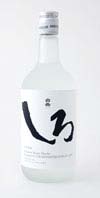
Hakutake Shiro (白岳 しろ / はくたけ しろ) Takahashi Shuzō, Kumamoto Prefecture, Japan
ABV: 25%, Kōji: rice (white kōji kin)
Distillation: low pressure
Recommended serving style:
Neat
Rocks
Mizuwari
Oyuwari
Comments: Shiro is a very light and easy-sipping kome shochu thanks to the use of low pressure distillation. It’s the simplest and softest of the bottles in this section, if not the entire chapter. There are lots of pairing possibilities here, such as smoked salmon or cheese. Much like Ginka Torikai, I recommend keeping the bottle chilled in case you might want to enjoy it neat.

Sennen Nebosuke (千年 寝坊助 / せんねん ねぼすけ) Kenjō Co., Fukuoka Prefecture, Japan
ABV: 25%, Koji: rice (yellow kōji kin)
Distillation: low pressure
Recommended serving style:
Neat
Rocks
Mizuwari
Oyuwari
Comments: This is an easy to drink, light on the attack, rice shochu. A crowd pleaser with its adorable label, the name of this shochu can loosely be translated to ‘overslept for a thousand years.’ It can be paired well with fried food and barbecued meats. As with the other rice shochu in this section, it tastes best at lower temperatures, and I usually drink it on the rocks.
Awamori
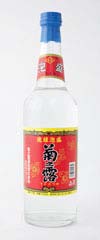
Kiku no Tsuyu (菊 之 露 / きく の つゆ) Kikunotsuyu Shuzō, Okinawa Prefecture, Japan
ABV: 30%, Kōji: rice (black kōji kin)
Distillation: atmospheric pressure
Recommended serving style:
Neat
Rocks
Mizuwari
Oyuwari
Comments: This is a smooth awamori from Miyakojima, a beautiful dab of land that is home to a total of seven Awamori distilleries if you count the two on the satellite island of Irabu. In addition to the most popular serving style, mizuwari, I highly recommend trying it oyuwari—especially if you reside in a more temperate climate. Keep in mind, however, that this is a 30% ABV spirit we’re dealing with here, so it is perhaps prudent to alter the ratio a bit. Maybe 4:6 (awamori: hot water) is a good starting point, and then adjust according to taste. Another way to enjoy awamori in the summer is to plop a lime wedge down in the bottom of a cocktail glass, throw some ice on top of it, and then fill with awamori.

Kumesen (久米仙 / くめせん) Kumesen Shuzō, Okinawa Prefecture, Japan
ABV: 30%, Kōji: rice (black kōji kin)
Distillation: atmospheric pressure
Recommended serving style:
Neat
Rocks
Mizuwari
Oyuwari
Comments: This awamori starts off with a citrusy fragrance, and you’ll find that it’s medium-bodied and slightly sweet when you first take a sip. However, depending on how cold you’ve made it, you’ll find that the sweetness gives way to a refreshing dryness. Pair this with red meat and even tofu dishes. Enjoyable either on the rocks or with several splashes of water, be careful not to get it mixed up with another delicious awamori, Kumejima Kumesen.
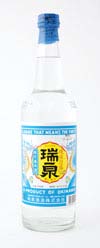
Zuisen (瑞泉 / ずいせん) Zuisen Shuzō, Okinawa Prefecture, Japan
ABV: 30-31%, Kōji: rice (black kōji kin)
Distillation: atmospheric pressure
Recommended serving style:
Neat
Rocks
Mizuwari
Oyuwari
Comments: This awamori presents itself with a sweet, almost brown sugar nose. But you may find that it’s drier than the aromas lead you to suspect. I think that Zuisen is best enjoyed on the rocks, but it should also keep people very happy in a tried-and-true mizuwari mix. Awamori in general, and Zuisen in particular, pairs nicely with Chinese food, and it goes without saying that it’s a safe bet any time you’re eating gōya chanpurū.
Brown sugar (kokutō) shochu

Asahi (朝日 / あさひ) Asahi Shuzō, Kagoshima Prefecture, Japan
ABV: 30%, Kōji: rice (white kōji kin)
Distillation: atmospheric pressure
Recommended serving style:
Neat
Rocks
Mizuwari
Oyuwari
Comments: Medium-bodied with a clean finish, this kokutō shochu does a good job of balancing its caramel sweetness with a warm richness of flavor. Asahi is tank-aged and works well as an accompaniment to creamy pastas or cheese fondue. You know that tomato and mozzarella slices with basil leaves and olive oil appetizer that appears everywhere during summer months? Try a glass of Asahi alongside it.
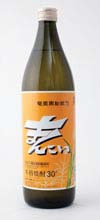
Mankoi (まんこい) Yayoi Shochu Jōzōjo, Kagoshima Prefecture, Japan
ABV: 30%, Kōji: rice (white kōji kin)
Distillation: atmospheric pressure
Recommended serving style:
Neat
Rocks
Mizuwari
Oyuwari
Comments: This beautiful shochu is cask-aged for at least three years before bottling, and it has a mellow attack that rounds into warm hints of rum. It’s a complex shochu that is nonetheless very easy to handle thanks to the extended time that it spent sleeping in an oak barrel. For me, this drink has the swagger to follow a savory meal, and it’s excellent slightly chilled in a brandy snifter.

Sango (珊瑚 / さんご) Nishihira Shuzō, Kagoshima Prefecture, Japan
ABV: 30%, Kōji: rice (white kōji kin)
Distillation: atmospheric pressure
Recommended serving style:
Neat
Rocks
Mizuwari
Oyuwari
Comments: Sango, which means coral in Japanese, is another offering from the beautiful, secluded islands that stretch south from Kagoshima proper toward the tropical paradise of Okinawa. This lace of islands is known as Amami, and it’s the only region where kokutō shochu is made. Sango, for its part, is tank-aged for a year which is why it lacks color, unlike its barrel-aged brethren. The result is a very dry shochu that doesn’t have as much sweetness as you might expect. It is tasty oyuwari, but try it on the rocks or mizuwari first. And don’t neglect to savor the rum notes on the nose before partaking.
Other
Aloe (aroe) shochu
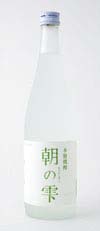
Asa no Shizuku (朝 の 雫 / あさ の しずく) Hana no Tsuyu, Fukuoka Prefecture, Japan
ABV: 23%, Kōji: rice (kōji kin type unknown)
Distillation: unknown
Recommended serving style:
Neat
Rocks
Mizuwari
Oyuwari
Comments: The aloe used here is sourced from Okinawa Prefecture, and the rice strain used in the kōji is actually the same high quality kome used in many fine nihonshu, Yamada Nishiki. There’s a very light butterscotch quality in the nose if you take just half a whiff. It’s a very smooth shochu that will remind you of rice but with fleeting bitter accents and a resulting refreshing quality. This is a good choice for before a meal or a Sunday afternoon out on the patio.
Buckwheat (soba) shochu

Unkai (雲海 / うんかい) Unkai Shuzō, Miyazaki Prefecture, Japan
ABV: 25%, Kōji: barley (white kōji kin)
Distillation: low pressure
Recommended serving style:
Neat
Rocks
Mizuwari
Oyuwari
Comments: This is a very tasty buckwheat shochu that I hope you can get your hands on at some point. Buckwheat is what soba noodles are made from. Unkai is a refreshing use of that grain and has found widespread popularity in Japan after hitting the market in 1973. The buckwheat aromas give way to a sweetness that belies the barley and rice used during fermentation. I prefer to drink this one on the rocks because it drops the sweetness just a tad, but you should also try it oyuwari for a drier finish. Unkai is a light and refreshing spirit that is often a good starting point for shochu beginners.
Chestnut (kuri) shochu
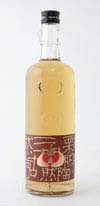
Sannen Koshu (三然 古酒 / さんねん こしゅ) Nishiyama Shuzō, Hyōgo Prefecture, Japan
ABV: 25%, Kōji: rice (kōji kin type unknown)
Distillation: unknown
Recommended serving style:
Neat
Rocks
Mizuwari
Oyuwari
Comments: At least 50% of the weight of this shochu’s ingredients are chestnuts, and it’s aged for more than three years in oak barrels. Perhaps the most interesting piece of the drink’s story is exactly where it’s stored—the distillery uses an abandoned train tunnel to let it mature at a constant cool temperature (10 degrees Celsius). From nose to finish, the chestnuts are firmly in command on this one, but there’s also a complimenting influence from the oak which adds depth to the sweetness. This shochu finishes softly after flaring some post-attack red fruit.
Green pepper (pīman) shochu

Piment (ぴめんと) Ochiai Shuzōjo, Miyazaki Prefecture, Japan
ABV: 25%, Kōji: rice (white kōji kin)
Distillation: unknown
Recommended serving style:
Neat
Rocks
Mizuwari
Oyuwari
Comments: This is a (green?) bell pepper shochu and another example of how English spellings can go a little awry. It says ‘Piment’ on the bottle, but it really should have an ‘o’ on the end because that’s how it’s pronounced in Japanese. On the back of the bottle it is mentioned that the inspiration for the name of this shochu was the Spanish word for pepper, ‘pimiento’, in which case they forgot two vowels plus the fact that pimientos are generally red. Whatever. I’m including this bottle here because it was a happy discovery for me, and you’ll enjoy the interplay of citrus and tangy notes. The pepper doesn’t blast away on the nose, but it comes through unmistakably on the palate.
Perilla (shiso) shochu
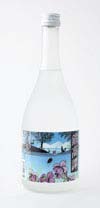
Tantakatan (鍛高譚 / たんたかたん) Oenon Group, Tokyo, Japan
ABV: 20%, Kōji: unknown
Distillation: unknown
Recommended serving style:
Neat
Rocks
Mizuwari
Oyuwari
Comments: This shochu is not actually honkaku, but I’ve included it because I’ve met several people from a variety of countries who quite like it. This is a blended (konwa) shochu, 88% kōrui (multiple-distilled) and 12% otsurui (single-distilled). In addition to shiso, sometimes referred to as basil’s Asian cousin, dates are added to the fermentation. It’s a simple, refreshing tipple that is easy to drink and best consumed on the rocks or with cool water. Avoid hot water with Tantakatan as an oyuwari mix can blow the shiso notes out of proportion. The production process has largely been kept a secret, so it’s the only bottle in this chapter for which both the type of kōji and distillation method remain a mystery to the general public.
Sesame (goma) shochu
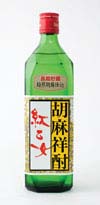
Beni Otome (べに 乙女 / べに おとめ) Beni Otome Shuzō, Fukuoka Prefecture, Japan
ABV: 25%, Kōji: rice (white kōji kin)
Distillation: low pressure
Recommended serving style:
Neat
Rocks
Mizuwari
Oyuwari
Comments: According to the label, sesame makes up at least 20% of the ingredients used to make this drink. In addition to the sesame and rice, barley is used to help round this tank-aged shochu out. The sesame is very apparent in the bouquet—quite similar to the complexity found in sesame oil and deepened by a whiff of steamed potatoes. Grilled sesame seeds come through on the palate, as does a late-arriving almost walnutty bitterness. If quieting the sesame down a little is what you’re after, then drink this one on the rocks. Drinking it oyuwari, on the other hand, will draw out the umami.